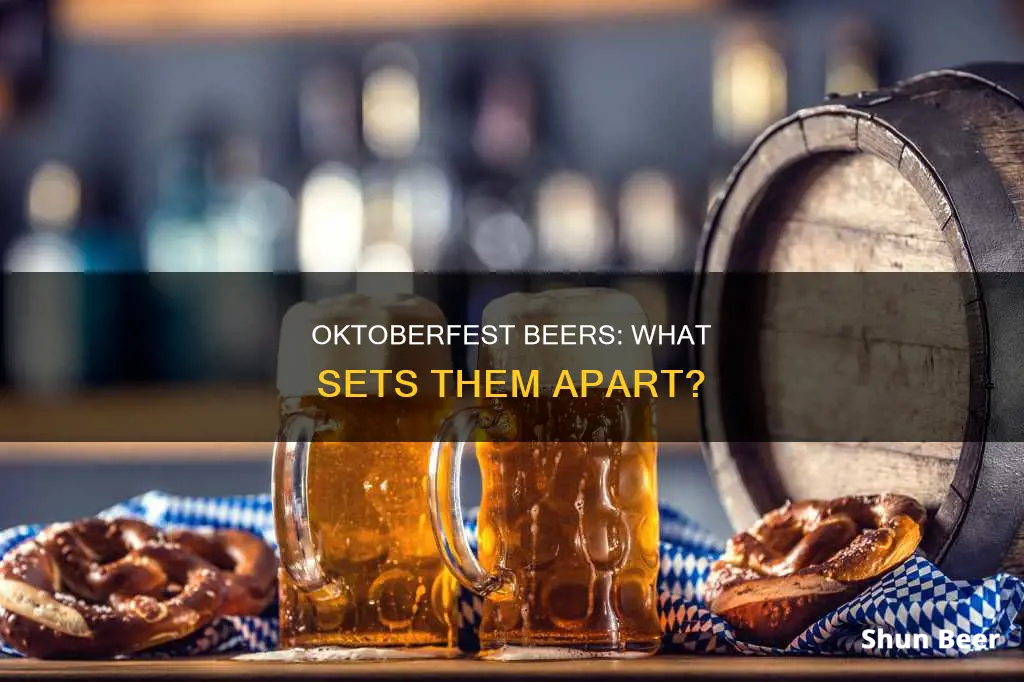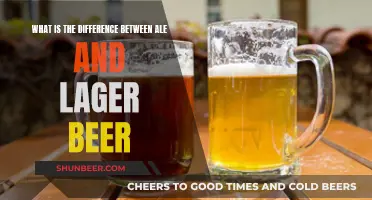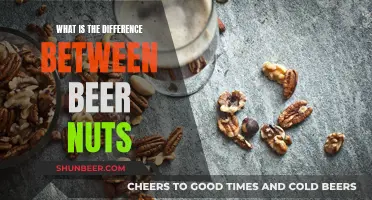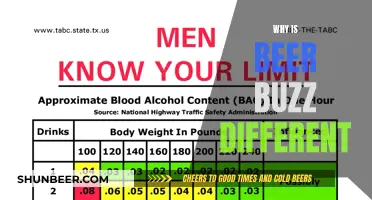
Oktoberfest beers are a bit of an oddity in the beer world, as they can be tricky to classify. The Oktoberfest beer category includes both beers made for serving at the official festival in Munich, Germany, and beers brewed in that style. The festival features only six local breweries that are permitted to serve their beers: Paulaner, Spaten, Hacker-Pschorr, Augustiner, Hofbrau, and Lowenbrau. These are the true Oktoberfest beers in their purest form. However, the Oktoberfest label can also be found on many other seasonal beers produced both inside and outside of Germany. While the flavour profiles vary, these beers often aim to mimic historical styles served at the official festival.
What You'll Learn

Oktoberfest beers are lagers
The original Märzen was described as "dark brown, full-bodied, and bitter". However, over time, Märzen has come to refer to a lager that varies in colour from pale to amber to dark brown. It has a medium to full body and a sweeter and often less hoppy flavour than other lagers.
Oktoberfest is a festival held annually in Munich, Germany, from mid-September to the first week of October. Only six local breweries are permitted to serve their beers at the festival: Paulaner, Spaten, Hacker-Pschorr, Augustiner, Hofbrau, and Lowenbrau. These are the only breweries that can name their beers 'Oktoberfestbier'.
Beers served at the festival today are golden lagers, which have replaced the darker amber Märzen that was traditionally served. However, amber-coloured Oktoberfest beers are still brewed in Munich and can be found in bars and restaurants around the city during the festival season.
Outside of Germany, particularly in the US, Oktoberfest beers are more likely to be amber-coloured Märzen. These beers are often sweeter than their German counterparts, with toasty and warm spice notes and a restrained hop bitterness.
Beer's Reaction to Containers: A Study
You may want to see also

There are two types: dark, malt-forward Märzen and lighter, hoppier Festbier
Oktoberfest beers can be tricky to classify. The Oktoberfest beer category includes both beers specifically made for serving at the official Oktoberfest festival and beers brewed in a similar style.
Within the family of German-brewed lagers, there are two types: dark, malt-forward Märzen and lighter, hoppier Festbier.
Märzen is a German amber lager that is dark copper to reddish-brown in colour. It has a crisp, smooth taste with sweet toasted bread and faint hints of spice. It is sweetish but with a noticeable noble hops bite and a dry finish. The typical ABV is 5-6%.
The name Märzen means "March beer". It applies to beers brewed in March and left to lager (condition) in cold cellars over the summer, to be tapped in early autumn. Summer brewing was prohibited in Germany for a long time to ensure good beer quality and prevent spoilage in high temperatures. These March beers were brewed with higher gravity (alcohol content) than regular lagers to ensure a longer shelf life.
In the 1970s, Märzen was replaced by a much lighter lager known as Festbier. Festbier is a strong, golden German lager with a long-lasting white head. It has traits similar to Helles and Maibock—a malty backbone, spicy and floral hop bite, a moderately full body, and a dry finish. The ABV is 6-6.5%.
Today, most of the beer consumed at the Oktoberfest festival is Festbier. It is golden in colour and has a distinct hop flavour. The malt flavour is more biscuit-like and subtle than that of amber Märzen.
What Makes Beer Gas Tanks Unique?
You may want to see also

They have a higher alcohol content than regular beers
Oktoberfest beers have a higher alcohol content than regular beers. The minimum alcohol content for Oktoberfest beers is 6% ABV, which is higher than most other lagers. The Augustiner Oktoberfest beer, for example, has an alcohol content of 6.3% or 6.5% depending on the source, while the Hofbräu Oktoberfest beer also has an alcohol content of 6.3%. The Paulaner Oktoberfest beer has an alcohol content of 5.9%, and the Spaten Oktoberfest beer has an alcohol content of 5.8%. These beers are typically brewed with higher gravity (alcohol content) than regular lagers to achieve a longer shelf life, as they were brewed in March and left to lager (condition) over the summer months until the early fall when they were served.
The higher alcohol content of Oktoberfest beers is due in part to the style of beer that was originally served at the festival. The first Oktoberfest beers were dark lagers known as Dunkel, which had a higher alcohol content than the lighter-coloured beers that would later become popular at the festival. As kilning technology improved and lighter malts became available, the beers served at Oktoberfest gradually became lighter in colour, eventually shifting to amber lagers known as Märzen. These amber lagers were easier to drink and had a lower alcohol content than the darker beers that came before them. However, they were still brewed with higher gravity and had a higher alcohol content than regular beers, typically falling in the range of 5-6% ABV.
In recent years, the beers served at Oktoberfest have become even lighter in colour, shifting from amber lagers to golden lagers known as Festbier. These golden lagers are still brewed to a higher gravity and have a higher alcohol content than regular beers, typically falling in the range of 6-6.5% ABV. The shift to lighter-coloured beers was driven in part by the desire to create a beer that was more refreshing and easier to drink, especially during the warm summer months when the festival takes place. By reducing the intensity of the beer and increasing its bitterness, breweries were able to create a beer that was more quaffable and appealing to attendees.
The higher alcohol content of Oktoberfest beers is also influenced by the brewing traditions and regulations of the region. All beers served at Oktoberfest in Munich must adhere to the Reinheitsgebot, which requires a minimum alcohol content of approximately 6% and allows only specific ingredients to be used in the brewing process. In addition, only breweries located within the city limits of Munich are permitted to serve their beers at the festival, further shaping the style and characteristics of Oktoberfest beers.
Beer Carbonation: CO2 Content Varies by Brew
You may want to see also

They are served in one-litre glasses
Oktoberfest is the world's largest beer festival, and it's held annually in Munich, Germany, from mid-September to the first week of October. The festival is a celebration of beer, with 7 million litres consumed each year.
The beers served at the festival are specially brewed for the occasion by six local breweries: Paulaner, Spaten, Hacker-Pschorr, Augustiner, Hofbrau, and Lowenbrau. These beers are typically stronger than regular beers, with an alcohol content of around 6%.
One of the most distinctive features of Oktoberfest is that the beers are served in one-litre glasses, known as a "Maß" or "Mass" (short for "Maßkrug"). These glasses hold 1,000 ml (34 ounces) of beer, and drinking from them is an art in itself.
The one-litre serving size is a traditional aspect of the festival, and it adds to the festive atmosphere. However, it's important to pace yourself when drinking these large servings, as the alcohol content can sneak up on you. The festival even has a special beer police squad, called the "Verein Gegen Betrügerisches Einschenken" (Association Against Fraudulent Pouring), to monitor the pouring of beer and ensure that the glasses are filled correctly.
When holding a Maß, it's recommended to put your hand through the handle and rest your thumb on top. This improves stability and helps prevent spills, especially when the glass is full and weighs around 2.3 kg (5.1 pounds). It's also considered proper etiquette to drink from the glass using just one hand.
Cheersing is a common practice at Oktoberfest, but it's important to do it safely. When clinking glasses, it's best to hold the glass by the handle to avoid smashing your fingers. And remember, when cheersing with others, it's customary to touch your glass to the table before taking a drink.
So, whether you're a local or a visitor, drinking beer from a one-litre glass at Oktoberfest is a unique and memorable experience. It's a testament to the festival's long-standing traditions and the Bavarian culture of celebrating beer.
Exploring Diverse Beer Markets: A Global Perspective
You may want to see also

They are best paired with salty foods
Oktoberfest beers are primarily lagers, with two types: the dark, malt-forward Märzen and the lighter, hoppier Festbier. The latter is the most common beer consumed at the festival. These beers are golden in colour, with a distinct hop flavour and a subtle, biscuit-like malt flavour.
When it comes to food pairings, salty snacks are an excellent choice to accompany an Oktoberfest beer. This is because salt neutralises bitter elements, allowing the drinker to enjoy the other characteristics of the beer. Salty pretzels, for example, are a classic pairing with Oktoberfest beers, as the saltiness enhances the beer's flavour without overwhelming it.
The Reissdorf German Kölsch, a bright and crisp beer from the kölsch heartland of Köln, Germany, is an excellent choice to accompany salty foods. Its refreshing nature makes it a perfect match for salt and mustard. Another great option is the Weihenstephaner Hefeweissbier or original Helles, also from Germany. These beers are very light and thirst-quenching, making them ideal for enjoying with a salty pretzel.
So, if you're looking to pair an Oktoberfest beer with some snacks, reach for something salty. It's a classic combination for a reason!
Beer Carbonation: Why the Fizz Differs
You may want to see also
Frequently asked questions
Oktoberfest beer is always a lager, whether Marzen-style or Vienna lager.
Marzen is a German amber lager, dark copper to reddish-brown in colour, with a sweet toasted bread aroma and faint hints of spice. Oktoberfestbiers tend to be paler and more similar to traditional lagers, or a Dortmunder-style lager.
Vienna lager tends to be lighter in colour due to the use of Vienna malt. It is also typically less malty and a bit more bitter than Marzen.
American Oktoberfest beers tend to lean more towards amber-coloured and slightly sweet Marzen lagers, whereas German Oktoberfest beers tend to be paler and more similar to traditional lagers.







